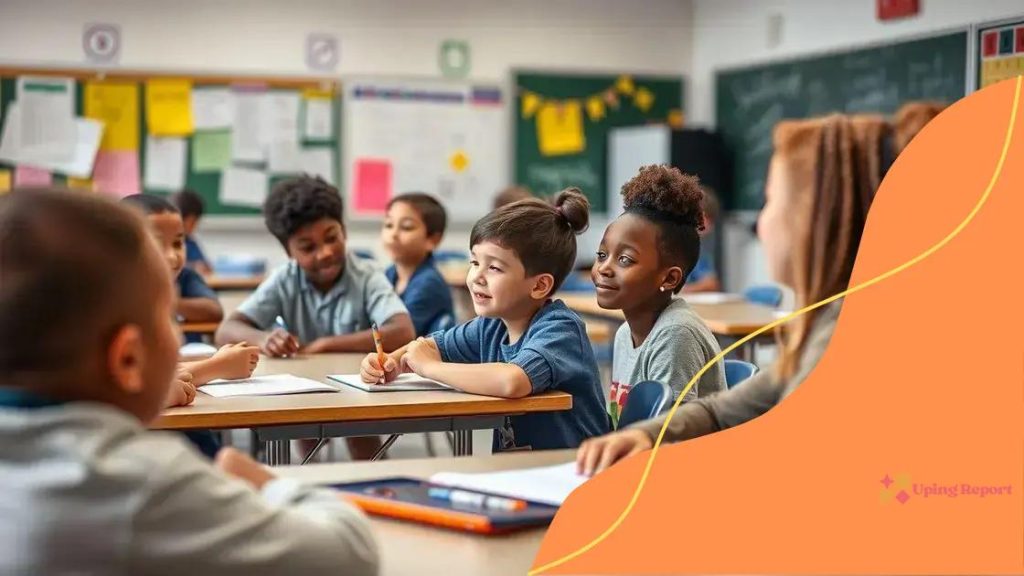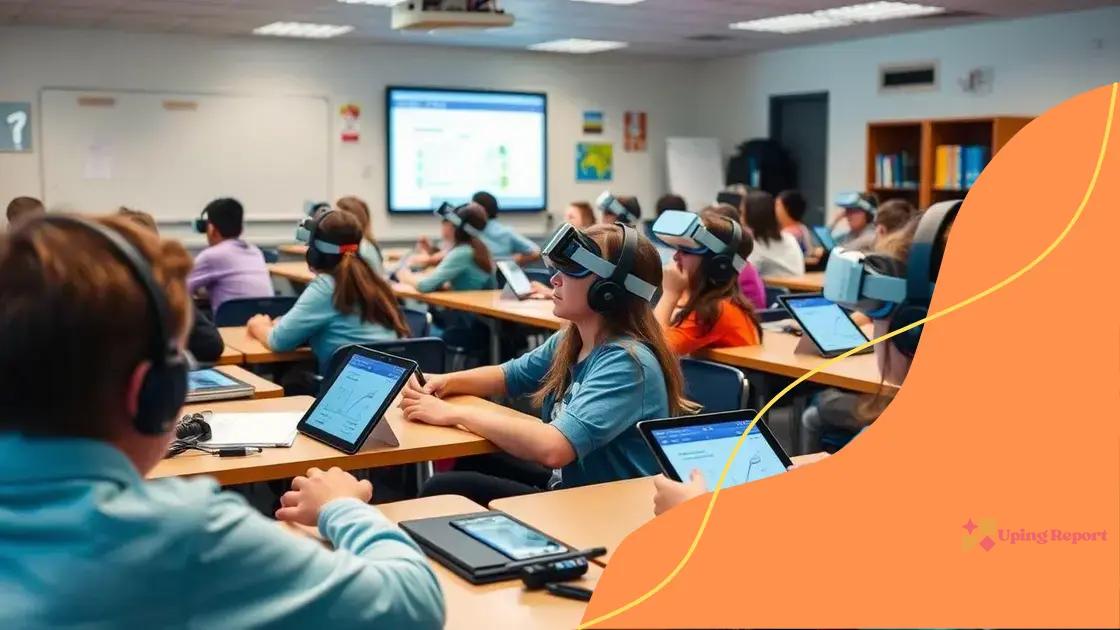K-12 education reforms: enhancing student success

K-12 education reforms aim to improve student outcomes by focusing on personalized learning, integrating technology, stakeholder engagement, and using data-driven decision-making to foster a supportive learning environment.
K-12 education reforms are reshaping the way students learn and grow. As schools strive to enhance their programs, it’s important for us to explore the implications of these changes.
Understanding K-12 education reforms
Understanding K-12 education reforms is crucial for grasping how changes impact students, teachers, and the overall educational landscape. These reforms aim to create better learning environments and improved outcomes for students.
Types of K-12 Education Reforms
K-12 reforms include several aspects such as curriculum redesign, funding adjustments, and policy changes. These reforms can vary widely from state to state, depending on local needs and educational goals.
- Curriculum innovations promoting critical thinking.
- Increased funding for under-resourced schools.
- Better teacher training and support systems.
- Integration of technology into learning environments.
The development of new curricula focuses on fostering skills relevant to today’s society, emphasizing not just rote memorization but also analytical and problem-solving abilities. Additionally, many reforms introduce technology into the classroom, which can enhance learning experiences when used effectively.
Challenges in K-12 Reforms
While the goals of K-12 education reforms are admirable, implementation can be challenging. Changes in policy can face resistance from various stakeholders, including teachers, parents, and school boards. Moreover, there is often a significant time lag between the conceptualization of reforms and their actual execution in classrooms.
Some significant challenges educators encounter include:
- Balancing standardized testing with innovative teaching methods.
- Ensuring equitable access to resources across districts.
- Addressing diverse learning needs within the same classroom.
Ultimately, understanding the intricacies of these reforms helps stakeholders navigate the shifts in educational policy more effectively, ensuring that they meet the diverse needs of all students.
Key trends driving changes in education
Key trends driving changes in education reshape how schools operate and engage with students. Recognizing these trends helps us understand the direction of K-12 education reforms.
Personalized Learning
One major trend is the focus on personalized learning. This approach tailors the educational experience to meet individual students’ needs, interests, and learning styles. By leveraging technology, educators can create unique paths for every student.
- Adaptive learning software adjusts to student performance.
- Individualized learning plans are developed for each student.
- Student choice in projects and topics enhances motivation.
In personalized learning environments, students may engage more deeply. They take ownership of their learning, which can lead to higher achievement levels.
Integration of Technology
The integration of technology into the classroom is another key trend. Interactive tools and digital resources are becoming commonplace in K-12 education. These technologies aim to enhance learning experiences and provide new opportunities for engagement.
Teachers are using tools such as:
- Online platforms for collaborative projects.
- Virtual reality for immersive learning experiences.
- Data analytics to track student progress.
This shift towards using technology not only supports traditional learning methods but also prepares students for the digital world they will face beyond school.
Focus on Social-Emotional Learning
Another trend is the emphasis on social-emotional learning (SEL). Schools are recognizing the importance of student well-being alongside academic achievement. Programs that promote emotional intelligence and resilience are now integrated into daily routines.
Benefits of SEL include:
- Improved student behavior and attendance.
- Enhanced academic performance.
- Stronger relationships among peers and teachers.
As education evolves, understanding these key trends provides insight into how K-12 education reforms aim to foster a more holistic approach to teaching and learning.
Impact of technology on K-12 education

The impact of technology on K-12 education is profound and far-reaching. With the rise of digital tools, classrooms are transforming into interactive learning environments that cater to diverse student needs.
Enhanced Learning Experiences
Technology facilitates enhanced learning experiences. Students today can access a wealth of information and resources at their fingertips. Online platforms and educational apps provide interactive content that engages students in new ways.
- Virtual simulations offer hands-on learning opportunities.
- Multimedia resources cater to various learning styles.
- Online collaboration tools help students work together effectively.
This accessibility allows learners to explore topics in depth and fosters a sense of curiosity. Educators can utilize these resources to complement traditional teaching methods, making lessons more engaging.
Personalized Learning Paths
Another key impact of technology is its role in creating personalized learning paths. Adaptive learning technologies tailor educational content to meet individual student needs. This personalized approach can significantly improve learning outcomes.
Features of personalized learning include:
- Real-time assessments to adjust difficulty.
- Custom learning materials based on student progress.
- Flexibility in pacing and learning pathways.
As a result, students can move at their own pace, taking the time they need to master concepts. This reduces frustration and enhances motivation, allowing learners to achieve their full potential.
Increased Engagement
Technology also contributes to increased student engagement. With the use of interactive tools and gamified learning, classrooms become vibrant spaces that inspire creativity. Students are more likely to participate when lessons are dynamic and involve technology.
Engaging technology tools can include:
- Educational games that teach problem-solving skills.
- Interactive whiteboards for collaborative activities.
- Educational podcasts and videos that present information in a fun way.
By integrating technology, teachers can create an exciting learning atmosphere that encourages students to take part actively. Understanding the impact of technology on K-12 education is essential for stakeholders aiming to harness its potential effectively.
Strategies for effective implementation
Strategies for effective implementation of K-12 education reforms are essential for ensuring that changes bring about positive outcomes. It is vital for school administrators and educators to work collaboratively to create a smooth transition.
Stakeholder Engagement
One effective strategy is to engage all stakeholders in the reform process. This includes teachers, parents, students, and community members. By involving them early on, schools can gather valuable insights and foster a sense of ownership over the changes.
- Conduct surveys to understand concerns and suggestions.
- Hold community meetings to discuss reform initiatives.
- Create focus groups to involve diverse perspectives.
When everyone feels heard, they are more likely to support and actively participate in the implementation process. Building relationships among stakeholders also helps to facilitate smoother changes.
Professional Development
Another critical component is providing ongoing professional development for teachers. Adequate training equips educators with the necessary skills and knowledge to effectively implement reforms.
Key aspects of professional development include:
- Workshops that focus on new teaching methods.
- Coaching and mentorship programs.
- Access to resources that support curriculum changes.
As teachers become more confident in their abilities, they can better support and engage their students, leading to improved educational outcomes.
Data-Driven Decision Making
Additionally, using data-driven decision-making can enhance the effectiveness of implementation strategies. Schools should regularly monitor progress and collect data to inform their decisions.
Using data effectively involves:
- Identifying key performance indicators for success.
- Assessing student progress to adjust strategies as needed.
- Analyzing feedback from stakeholders to refine approaches.
Data-driven decisions enable schools to recognize what is working and identify areas for improvement, ensuring a more responsive implementation process.
Implementing these strategies allows K-12 education reforms to be more effective, fostering an educational environment that promotes success for all students.
Measuring the success of K-12 reforms
Measuring the success of K-12 reforms is crucial for understanding their effectiveness and impact on students. By examining various metrics, educators and policymakers can make informed decisions to enhance the learning experience.
Key Performance Indicators
Establishing clear key performance indicators (KPIs) helps schools focus on measurable outcomes. These indicators assess various aspects of student success and educational quality.
- Standardized test scores to evaluate academic achievement.
- Graduation rates to track student completion.
- Teacher effectiveness measures based on evaluation systems.
Using these KPIs, schools can set goals and monitor progress over time, providing valuable data to guide decisions about educational strategies.
Gathering Student Feedback
Another effective method to measure reform success is through gathering feedback from students. Surveys and focus groups can provide insights into students’ experiences and perceptions of changes in the educational environment.
Feedback can cover areas such as:
- Engagement levels in classrooms.
- Perceived support from teachers.
- Access to resources and learning materials.
By listening to students, schools can identify areas needing improvement and adjust their approaches accordingly to enhance the overall educational experience.
Longitudinal Studies
Moreover, conducting longitudinal studies can provide a deeper understanding of the long-term impacts of K-12 reforms. Tracking a cohort of students over several years helps educators identify trends and shifts in academic performance.
Longitudinal studies can reveal:
- Long-term retention of knowledge and skills.
- Post-graduation outcomes such as college enrollment rates.
- Social-emotional development throughout schooling.
These insights contribute to refining educational practices and ensuring that reforms fulfill their intended goals. Measuring success using a combination of quantitative data and qualitative feedback creates a comprehensive overview of the effects of K-12 reforms on students and schools.
FAQ – Frequently Asked Questions about K-12 Education Reforms
What are the main goals of K-12 education reforms?
The main goals are to improve student outcomes, enhance learning environments, and ensure equitable access to quality education.
How can technology impact K-12 education?
Technology can enhance learning experiences, provide personalized learning paths, and increase student engagement through interactive tools.
Why is stakeholder engagement important in education reforms?
Engaging stakeholders, such as teachers, parents, and students, builds trust and support, ensuring successful implementation of reforms.
What methods can be used to measure the success of K-12 reforms?
Success can be measured through key performance indicators, student feedback, and longitudinal studies that track student progress over time.
